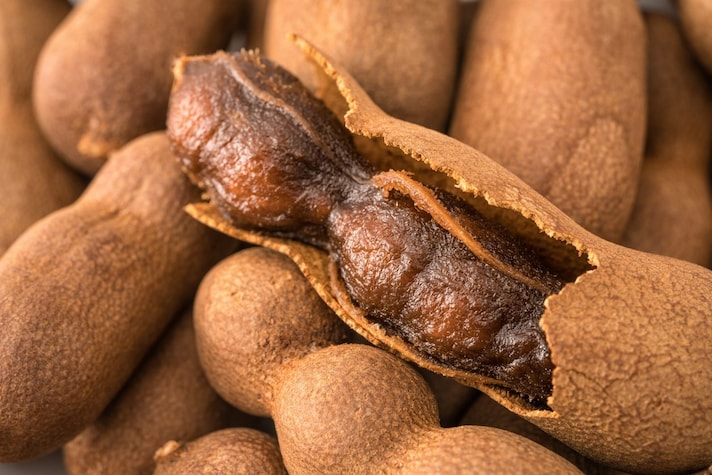
Tamarind is a tangy, sweet, and slightly sour fruit that grows on the Tamarind tree. Its pod-like outer shell encases a sticky, dark brown pulp, which is the edible part used in cooking. Common in Indian, Southeast Asian, and Middle Eastern cuisines, tamarind brings a unique balance of flavors to dishes, ranging from sauces and chutneys to curries and drinks.
Why Tamarind Is So Special
What makes tamarind stand out is its complex flavor. Its tartness, combined with natural sweetness, gives it a versatility that works both in savory and sweet dishes. This duality allows tamarind to be used in everything from spicy curries to refreshing beverages. It’s also incredibly aromatic, with a hint of earthiness that adds depth to any recipe. Plus, its tangy kick can act as a natural substitute for citrus in certain recipes, making it a useful pantry staple.
Nutritional Benefits of Tamarind
Beyond its rich flavor, tamarind offers a number of health benefits:
- Rich in antioxidants – Tamarind is packed with vitamins C and E, which help protect against free radicals and boost immunity.
- Supports digestion – Known for its digestive properties, tamarind can help with constipation and promote a healthy gut.
- Anti-inflammatory – The compounds in tamarind may help reduce inflammation, which is beneficial for conditions like arthritis.
- Good source of iron – Tamarind is rich in iron, which is essential for red blood cell production and helps combat fatigue.
- Low in calories – Despite its sweetness, tamarind is low in calories, making it a healthy addition to a balanced diet.

How to Use Tamarind in Cooking
Tamarind is an incredibly versatile ingredient that can be used in various forms: fresh, dried, or as a paste. It can add a unique tangy kick to a wide range of dishes. Here are some ways to incorporate tamarind into your cooking:
1. In Sauces and Marinades
Tamarind’s tangy-sweet profile makes it a perfect base for sauces and marinades. It’s commonly used in Indian curries, pad thai, and barbecue sauces, where it balances spice and sweetness.
Try This: Make a tamarind chutney by mixing tamarind paste with sugar, spices, and a bit of water to create a tangy-sweet sauce for grilled meats or appetizers.
2. In Soups and Stews
Tamarind is often added to soups and stews to provide a depth of flavor and acidity. Its tanginess can enhance the overall taste of dishes like sour soups and vegetarian curries.
Try This: Add a spoonful of tamarind paste to a pot of vegetable curry or sour tamarind soup for an authentic, tangy flavor that pairs perfectly with rich, creamy ingredients.
3. In Drinks and Refreshments
Tamarind is used in a variety of refreshing drinks and beverages. From Indian tamarind juice (imli sharbat) to Mexican aguas frescas, it’s a perfect way to cool down with a sweet and sour drink.

Try This: Mix tamarind paste with sugar, lime juice, and water to create a refreshing, tangy tamarind drink—perfect for hot weather.
4. In Desserts
While tamarind is known for its savory uses, it also shines in sweet dishes. Its natural sweetness and acidity can balance desserts, from sorbets to candies.
Try This: Make a tamarind sorbet by mixing tamarind pulp with sugar, water, and a touch of lime juice for a tangy, refreshing treat.
5. As a Flavor Enhancer
Tamarind can be used in small amounts to enhance the flavor of sauces, soups, and even rice dishes. A little bit goes a long way in bringing complexity and balance to your cooking.
Try This: Add a teaspoon of tamarind paste to your rice pilaf or biryani to deepen the flavor and add a tangy note that complements the spices.
How to Choose and Store Tamarind
Fresh tamarind is typically available in pods at specialty markets. You can easily extract the pulp by peeling off the outer shell and removing the seeds. Tamarind paste or tamarind concentrate is often sold in jars and is more convenient for everyday cooking.
To store tamarind paste, keep it in an airtight container in the refrigerator, where it can last for several months. If using fresh tamarind, you can refrigerate the pulp or freeze it for later use.

Final Thoughts
Tamarind is a flavor powerhouse, adding a tangy, sweet, and savory complexity to dishes. Whether you’re using it in curries, sauces, drinks, or desserts, it’s an ingredient that can enhance both traditional recipes and modern twists. With its health benefits and culinary versatility, tamarind is a must-have ingredient for any home cook looking to elevate their meals.
;Resize,width=767;)
